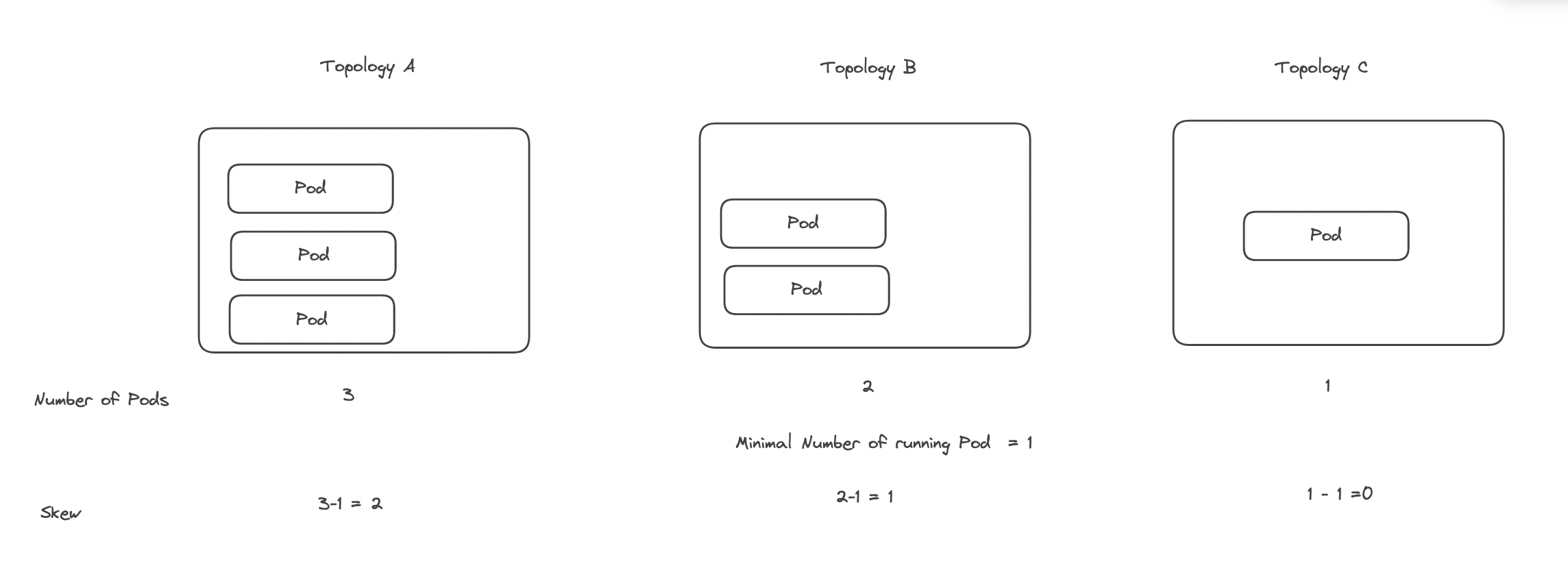前兩天我們介紹了
已經能靈活地引導 scheduler 幫我們把 Pod 調度到我們期待的 Worker Node 了。
但也發現若希望 Pod 平均分散到 Worker Node,仍然會遇到一些問題
這兩種問題可能會成為降低可用性的因素,所以今天要介紹的 Pod Topology Spread Constraints 就是專門解決此問題而生的設計的。
`Pod Topology Spread Constraints`` 的目的是將 Pod 儘可能均勻地分散到不同的 topology 中,例如不同的 Node、Region 或 Zone。其核心概念是 skew,即每組 Pod 在不同 topology 中的分布差異。
skew = Pods number matched in current topology - min Pods matches in a topology

圖檔來源: HWCHIU 學習筆記 / 解密 Assigning Pod To Nodes(下)
以上圖為例,有三個 topology 分別運行著 3、2、1 個 Pod,因此可以計算出最少 Pod 數量 min Pods matches in a topology 為 1。每個topology的 skew 值如下:
1
3
2 (3 - 1)
2
1 (2 - 1)
1
0 (1 - 1)
瞭解 skew 計算方式後,Pod Topology Spread Constraints 的配置變得更為直觀。
spec:
topologySpreadConstraints:
- topologyKey: <string>
maxSkew: <integer>
labelSelector: <object>
whenUnsatisfiable: <string>
topologyKey: 定義按哪個 Node Label 來劃分topology,類似於 Inter-Pod Affinity 的用法。maxSkew: 每個 topology 中的最大 skew 限制,即 Pod 分布不均勻的容忍度。labelSelector: 指定哪些 Pod 需要參與計算。whenUnsatisfiable: 當全部的 topology 都不滿足 maxSkew 的條件時的處理方式
DoNotSchedule: (Default) 不調度該 Pod,該 Pod 會處於 PendingScheduleAnyway: 仍然調度該 Pod,並優先選擇 Skew 低的 topology。我們來看一個使用範例
圖檔來自: Kubernetes 官方
當我們 或 HPA(Horizontal Pod Autoscaling) 要新增一個 Pod(label app=foo) 的副本時,目前兩個 topoloy 中該 Pod 的分佈為 2,0 (zone2 中的 Pod label 不符合條件,故不算在內)。
故 scheduler 會計算當把 Pod 調度到該 topology 時,是否超過 maxSkew 的配置,依此為例
3,不符合 maxSkew: 1 的條件,故不可調度到該 topology0,符合 maxSkew: 0 的條件,故可以調度到該 topology與 Inter-Pod Affinity 相比較,Pod Topology Spread Constraints 提供的 maxSkew 與 whenUnsatisfiable,讓 Pod 能均勻分佈到每個 topology,且不再有每個 topology 只能運行一個 Pod 的限制,大大的提高資源利用率。
在某些情境下,Pod 的分佈可能與 maxSkew 設定不符,特別是在 Deployment 進行 Rolling Update 時,會出現新舊版本的 Pod 同時被 LabelSelectors 選中的情況。
圖檔來自: Avoiding Kubernetes Pod Topology Spread Constraint Pitfalls
假設目前 Pod 均勻分佈在三個topology中,其中一個 Pod 為舊版本。因為三個 topology 的 skew 值皆為 0,新的 Pod 可以被部署到任何一個 topology。這可能導致以下情況:
圖檔來自: Avoiding Kubernetes Pod Topology Spread Constraint Pitfalls
例如,第三個新版本的 Pod 被調度到 AZ1,而 AZ3 的舊版本 Pod 在完成 Rolling Update 後被 Terminated,最終導致 Pod 分佈變為 2,1,0,違反了 maxSkew: 1 的限制。
為了避免這種情況,應該使用 Pod Topology Spread Constraints 的 matchLabelKeys 屬性,搭配 Deployment 自動為 Pod 添加的 pod-template-hash label。
📘 每當 Deployment 的
spec.template更改時,都會得到一個 hash 值,Pod 上能透過pod-template-hashlabel 獲取該 hash 值。
Deployment yaml 片段 範例如下:
spec:
containers:
- name: nginx
image: nginx:latest
topologySpreadConstraints:
- maxSkew: 1
topologyKey: kubernetes.io/hostname
whenUnsatisfiable: DoNotSchedule
labelSelector:
matchLabels:
app: nginx
matchLabelKeys:
- pod-template-hash
當在計算 skew 時,因 pod-template-hash label 的值不同,會將新舊版本的 Pod 分開計算 skew。回到 Rolling Update 的例子,這次的計算結果如下:
圖檔來自: Avoiding Kubernetes Pod Topology Spread Constraint Pitfalls
這次計算如下
0 (因為舊版本的不計算在內,而 AZ3 無任何匹配的 Pod,因此為 0)1
1 (1 - 0)
1=1 (1 - 0)
0
0 (0 - 0)
因此,第三個新版本的 Pod 將被正確地均勻分佈到 AZ3。
Pod Topology Spread Constraints 提供了一個有效的機制,確保 Pod 的均勻分佈。透過設定 maxSkew 和 topologyKey,避免 Pod 過度集中於特定topology 內,進而提升應用的高可用性與資源利用效率。
此外,配合 matchLabelKeys 和 pod-template-hash,可以避免新舊版本的 Pod 被誤算在同一 topology 中,進一步保證更新過程中的分佈一致性與資源平衡。這樣的機制不僅增強了 Kubernetes 調度的靈活性,也確保了部署時的穩定性與可擴展性。
